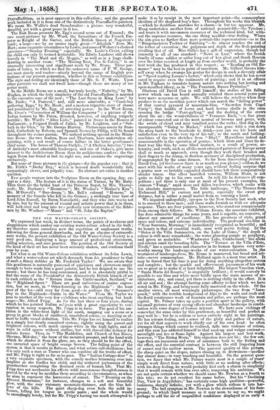$ift Attg.
TIER ROYAL ACADEMY EXHIBITION.
The private view of the Royal Academy, which took place yesterday, disclosed an unusually good exhibition. There is effort, discipline, emu- lation; resolution and power to do well, though the aspiration of the artists does not keep pace with their mastery. Most of the exhibitors are at their very best ; yet the number of very striking works is not great. On the whole, however, this ought not to be called a bad sign. In the few words we have to say on the present occasion, we of course propose to accomplish nothing beyond the bare mention of the most prominent works. And first, to name the absentees—we miss Sir Charles Eastlake, and Messrs. Dyce, Herbert, Maelise, and Millais, out of the Academician body, and most especially Mr. Holman Hunt among the non-Academicians; the loss of the two latter being a most serious oue both to the Prmraffaelite and to the general strength of thc exhibition. However, the whole body of our art is gradually settling itself into
Prairaffaelitism, as is most apparent in this collection ; and the greatest work included in it is from one of the distinctively Praeraffaelite painters. We mean Mr. Wallis's dead Stonebreaker : a picture very wonderful, dreadful, yet with a great peace in it too.
The East Room presents Mr. Egg's second scene out of Esmond; the two court-pictures by Mr. Ward, the Investiture of the French Em- peror as Knight of the Garter, and the British Queen at Napoleon's tomb; a large—we-by no means imply great—" Athaliah" from Mr. Hart; some exquisite orientalisrn s by Lewis, and some of Webster's choicest suecesses—" Sunday Evening" especially. Mr. Leslie's Christ calling the child can only be termed deplorable. Sir Edwin Landseer still showa bravely in "The Maid and the Magpie," as well as in a huge chalk- drawing in another room : "The Missing Boat, Pas de Calais," is an unusually interesting and significant work by Mr. Stone. Three por- traits of ladies, to which we find the unknown name of F. W. George, are most stately and tender—utterly beyond the range of English por- traiture of our present generation, whether in this or former exhibitions. The style and feeling are identically those of Mr. G. F. Watts. Upon other portraits we shall not dwell here—though there are many of su- perior merit.
In the Middle Room are a small, but truly lovely, "Nativity," by Mr. Hughes, in which the holy simplicity of the old Praeraffaelism is married to the executive ease of the new ; "The Last Scene in King Lear," by Mr. Poole; "A Pastoral," and, still more admirable, a "Coast-boy gathering Eggs," by Mr. Rook; and a modern tripartite story of shame and punishment by Mr. Egg, of arresting power. In the West Room, Mr. Cross's "Coronation of William the Conqueror" ; a picture of the Indian horrors by Mr. Paton, divested, however, of anything vulgarly horrible ; Mr. Ward's "Alice Lisle," painted in fresco in the Houses of Parliament; a Feigned Death of Juliet, by Mr. Leighton, and a "Sab- bath in the Glen," by Mr. George Harvey. Picturesque coasts by Stan- field, Cathedrals by Roberts, and Spanish Scenes by Philip, will be found throughout the rooms passim. We noticed nothing special in the Minia- ture Room : the two leaders, Ross and Thorburn, have undertaken oil- painting, with a sad result of coarse failure in the latter gentleman's chief essay. The house of Thomas Carlyle, (" A Chelsea Interior,") two of Anthony's most admirable landscapes, and one of Oakes's, give more interest to the Architecture Room than its architecture confers : the Oc- tagon Room has found at last its right use, and contains the engravings exclusively. But none of these pictures is the picture—for the popular eye : that is Mr. Frith's "Derby Day," which is beyond doubt wonderfully full, surpassingly clever, and palpably true. Its abstract art-value is another question.
Few people venture into the Sculpture Room on the opening day, ex- cept as a duty. The feature of it is the statue of Turner, by Mr. Badly. Then there are the bridal bust of the Princess Royal, by Mrs. Thorny- croft; Mr. Durham's " Hermione"; Mr. Weekes's "Mother's Kiss"; Mr. M‘Dowell's "Day-dream"; Mr. Bell's colossal "Honour," in memory of the Guards who fell in the Crimea ; a strikingly true bust of Lord John Russell, by Baron Marochetti ; and they who rate works not by size, but by the amount of mental and artistic power that is in them, will look close and long into two perfectly new treatments of the Bible- men by Mr. Woolner—" Moses" and "St. John the Baptist."



































 Previous page
Previous page